Architecture of Turkey
Architecture of Turkey or Turkish Architecture in the Republican Period refers to the architecture practised in the territory of present-day Turkey since the foundation of the republic in 1923. In the first years of the republic, Turkish architecture was influenced by Seljuk and Ottoman architecture, in particular during the First National Architectural Movement (also called the Turkish Neoclassical architecture movement.) However, starting from the 1930s, architectural styles began to differ from traditional architecture, also as a result of an increasing number of foreign architects being invited to work in the country, mostly from Germany and Austria.[1] The Second World War was a period of isolation, during which the Second National Architectural Movement emerged. Similar to Fascist architecture, the movement aimed to create a modern but nationalistic architecture.[2]
| Part of a series on the |
| Culture of Turkey |
|---|
 |
| History |
| People |
| Languages |
| Cuisine |
| Festivals |
| Religion |
| Art |
| Literature |
| Sport |
|
Starting from the 1950s, isolation from the rest of the world began to diminish, which enabled the Turkish architects to experiment with new styles and become increasingly inspired by their counterparts in the rest of the world. However, they were largely constrained by the lack of technological infrastructure or insufficient financial resources until the 1980s.[3] Thereafter, the liberalization of the economy and the shift towards export-led growth[4] paved the way for the private sector to become the leading influence on architecture in Turkey.
1920s to early 1930s: First national architectural movement
The First National Architectural Movement (Turkish: Birinci Ulusal Mimarlık Akımı) was an architectural movement led by Turkish architects Vedat Tek (1873–1942) and Mimar Kemaleddin Bey (1870–1927). Followers of the movement wanted to create a new and "national" architecture, which was based on motifs from Seljuk and Ottoman architecture. The movement was also labelled Turkish Neoclassical architecture, or the National Architectural Renaissance.[5] Other prominent followers of this movement were Arif Hikmet Koyunoğlu (1888–1982) and Giulio Mongeri (1873–1953).[6] Notable buildings from this era are the Istanbul Main Post Office (1905–1909), Tayyare Apartments (1919–1922),[7] Istanbul 4th Vakıf Han (1911–1926),[8] State Art and Sculpture Museum (1927–1930),[9] Ethnography Museum of Ankara (1925–1928),[10] Bebek Mosque,[11] and Kamer Hatun Mosque.[12][13]

 Istanbul Main Post Office interior
Istanbul Main Post Office interior

_the_Building_of_Ziraat_Bankas%C4%B1_(Agricultural_Bank)%252C_1930s_(16851406391).jpg.webp) First Ziraat Bank Headquarters in Ankara
First Ziraat Bank Headquarters in Ankara

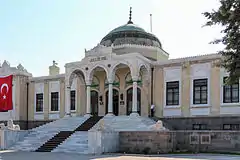 Ethnography Museum of Ankara was designed by architect Arif Hikmet Koyunoğlu (1925-1928).
Ethnography Museum of Ankara was designed by architect Arif Hikmet Koyunoğlu (1925-1928). Ankara Palace
Ankara Palace Denizli Gazi Mustafa Kemal Elementary School (1932)
Denizli Gazi Mustafa Kemal Elementary School (1932)
1930s to 1950s: Modernism and the influence of foreign architects
The Bauhaus style Florya Atatürk Marine Mansion (1935) and the Art Deco style Ankara Central Station (1937) are among the notable examples of this era.[14][15] As there were not enough architects in Turkey until the 1950s, various architects were invited by the government from Germany, Austria, Switzerland and France, in order to manage the rapid construction of the new capital Ankara. About 40 architects and urban planners designed and oversaw various projects (mostly in Ankara, and to a lesser extent in Istanbul and Izmir) between 1924 and 1942. Among them were Gudrun Baudisch, Rudolf Belling, Paul Bonatz, Ernst Arnold Egli, Martin Elsaesser, Anton Hanak, Franz Hillinger, Clemens Holzmeister, Henri Prost, Paolo Vietti-Violi, Werner Issel, Hermann Jansen, Theodor Jost, Heinrich Krippel, Carl Christoph Lörcher, Robert Oerley, Bernhard Pfau, Bruno Taut and Josef Thorak.[1][2]
Selected examples of buildings from this era are the Bauhaus style Florya Atatürk Marine Mansion (1935) designed by Seyfi Arkan; the Art Deco style Ankara railway station (1937) designed by Şekip Akalın; the Court of Cassation building (1933–35) designed by Clemens Holzmeister; the Faculty of Languages, History and Geography building (1937) of Ankara University designed by Bruno Taut; and the Grand National Assembly of Turkey building (1938–63) designed by Clemens Holzmeister.[14]
 Designed by Seyfi Arkan, Florya Atatürk Marine Mansion (1935) is a notable Bauhaus style building in Istanbul.
Designed by Seyfi Arkan, Florya Atatürk Marine Mansion (1935) is a notable Bauhaus style building in Istanbul..jpg.webp) Designed by Şekip Akalın, Ankara Central Station
Designed by Şekip Akalın, Ankara Central Station
.jpg.webp) The Faculty of Languages, History and Geography building (1937) of Ankara University
The Faculty of Languages, History and Geography building (1937) of Ankara University The Faculty of Law building (1937) of Ankara University
The Faculty of Law building (1937) of Ankara University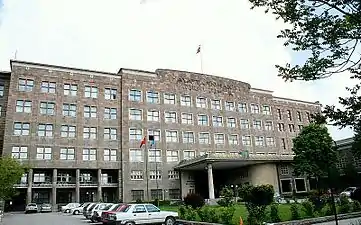 The Faculty of Languages, History and Geography building (1937) of Ankara University was designed by Bruno Taut.
The Faculty of Languages, History and Geography building (1937) of Ankara University was designed by Bruno Taut. The Grand National Assembly of Turkey building (1938–63) in Ankara was designed by Clemens Holzmeister.
The Grand National Assembly of Turkey building (1938–63) in Ankara was designed by Clemens Holzmeister.
Second national architectural movement
Inspired by the design characteristics of Fascist architecture in Italy and Nazi architecture in Germany, which sought a modern interpretation of Neoclassical architecture (i.e. the architecture of a modern era Roman Empire, according to their ideologies), there was a trend towards creating a new national architecture in Turkey around the 1940s.[2][16][17] The movement was called the Second National Architectural Movement (Turkish: İkinci Ulusal Mimarlık Akımı). The large number of foreign architects employed in Turkey in this period (especially from Germany and Austria) was a major factor in the introduction of these architectural movements and their stylistical characteristics. The pioneers of the movement in Turkey were Sedad Hakkı Eldem, Ekrem Hakkı Ayverdi[18] and Emin Onat. In order to lead this movement, Sedad Hakkı Eldem, who was a professor, held National Architecture seminars at the Mimar Sinan University of Fine Arts, focusing on the traditional Turkish house styles.[19]
Similar to their contemporary equivalents in Italy and Germany, the government buildings of this style in Ankara and Istanbul had typically large proportions (high ceilings, high windows, etc.) in order to give the impression of a strong state authority. Some of them also had monumental facade designs reminiscent of Neoclassical architecture; but with more modern and plain rectangular shapes, symmetry, simplicity, and a general lack of ornateness.
Some of the buildings related to this style are the Ankara Opera House designed by Şevki Balmumcu (1933–34) and renovated by Paul Bonatz (1946–47); the TCDD General Headquarters Building designed by Bedri Uçar in 1938; Istanbul University Faculty of Science and Faculty of Literature buildings (1944–52); Anıtkabir (1944–53); Istanbul Radio Headquarters (1945–49); Şişli Mosque (1945–49); and the Çanakkale Martyrs' Memorial (1954–60). The movement was particularly influential between 1935 and 1950. From the 1950s, the influence of this style started to diminish due to the next wave of influences, especially International Style and Rationalism.[19]
%252C_1934_(16826593236).jpg.webp)
 TCDD General Headquarters Building, designed by Bedri Uçar (1939-41).
TCDD General Headquarters Building, designed by Bedri Uçar (1939-41).
 Istanbul University Faculty of Science and Faculty of Literature Buildings, designed by Sedad Hakkı Eldem and Emin Halid Onat (1944–52).
Istanbul University Faculty of Science and Faculty of Literature Buildings, designed by Sedad Hakkı Eldem and Emin Halid Onat (1944–52).


1950s and more Western influence
At the beginning of the 1950s, a new generation of architects such as Nevzat Erol, Turgut Cansever, Abdurrahman Hancı, Cengiz Bektaş, Hayati Tabanlıoğlu, Enver Tokay, İlhan Tayman and Yılmaz Sanlı became more influential in the architectural arena. These were architects who either studied in Europe or had information of the modernist architecture of the time. Their quest for modernist architecture was in line with the International Style and Rationalism. However, the development of the Turkish economy was an important factor as well. Even though Turkish architects were able to follow up on the modern design of important architects of the time, they were constrained by the lack of technological infrastructure or insufficient financial resources.[3][13]
Selected examples of buildings from this era are the Anadolu Club Hotel (1951–1957) in Büyükada designed by Turgut Cansever and Abdurrahman Hancı; Hilton Istanbul Bosphorus (1952–1955) designed by Skidmore, Owings & Merrill and Sedad Hakkı Eldem; Istanbul Municipality Headquarters (1953–1960) designed by Nevzat Erol; Emek Business Center (1959–1965) in Ankara designed by Enver Tokay and İlhan Tayman; and Tekel Headquarters (1958–1960) in Istanbul designed by Yılmaz Sanlı and İlhan Tayman.[3]
One of the most important developments of this period was the establishment of the Chamber of Architects of Turkey in 1954. Various professional organizations for architects had existed beforehand, but there were no laws for the architectural profession until 1954.[20] Brutalist architecture become popular during 1950s, the work of Behruz Çinici in Middle East Technical University is the best example of this era.


 Istanbul Metropolitan Municipality City Hall was designed in 1953 by Nevzat Erol.
Istanbul Metropolitan Municipality City Hall was designed in 1953 by Nevzat Erol. InterContinental Hotel, formerly Sheraton Istanbul, was designed in 1959 by AHE and Rolf Gutbrod.
InterContinental Hotel, formerly Sheraton Istanbul, was designed in 1959 by AHE and Rolf Gutbrod..jpg.webp) Middle East Technical University Rectorate Building
Middle East Technical University Rectorate Building Middle East Technical University Pedestrian Way
Middle East Technical University Pedestrian Way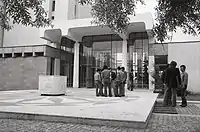 Middle East Technical University Library
Middle East Technical University Library Middle East Technical University Library
Middle East Technical University Library.jpg.webp) Middle East Technical University Faculty of Architecture
Middle East Technical University Faculty of Architecture.jpg.webp) Middle East Technical University Rectorate Building
Middle East Technical University Rectorate Building Middle East Technical University Faculty of Architecture
Middle East Technical University Faculty of Architecture.jpg.webp) Middle East Technical University Faculty of Architecture
Middle East Technical University Faculty of Architecture.jpg.webp) Middle East Technical University Faculty of Architecture
Middle East Technical University Faculty of Architecture.jpg.webp) Rıza Derviş House, also known as Derviş Manizade Mansion, built 1956-1957, is one of two buildings designed by Sedad Hakkı Eldem that was realized on Büyükada
Rıza Derviş House, also known as Derviş Manizade Mansion, built 1956-1957, is one of two buildings designed by Sedad Hakkı Eldem that was realized on Büyükada.jpg.webp) Rıza Derviş House. Architect, Sedad Hakkı Eldem was inspired by modernist architecture, which is evident not only in the architecture of the house, but also in the simplicity of the garden and its furniture
Rıza Derviş House. Architect, Sedad Hakkı Eldem was inspired by modernist architecture, which is evident not only in the architecture of the house, but also in the simplicity of the garden and its furniture.jpg.webp) Rıza Derviş House is considered an experimental project in rationalism, a trend that became popular after World War II
Rıza Derviş House is considered an experimental project in rationalism, a trend that became popular after World War II.jpg.webp) Rıza Derviş House built in 1956-1957
Rıza Derviş House built in 1956-1957.jpg.webp) Rıza Derviş House built in 1956-1957
Rıza Derviş House built in 1956-1957.jpg.webp) Rıza Derviş House built in 1956-1957
Rıza Derviş House built in 1956-1957.jpg.webp) Rıza Derviş House built in 1956-1957
Rıza Derviş House built in 1956-1957
1960s and 1970s
Following the 1960 coup d'état, Turkey endured various kinds of political and economic crises which affected the construction industry as well as the architectural sector. Despite these hardships, architects were able to design some important buildings. Abandoning Rationalism, Turkish architects tried to design their buildings in more flexible and fragmented forms. Important works from this period are the Vakıflar Hotel in Istanbul (1968, today the Ceylan Intercontinental Hotel), Middle East Technical University Campuses (1961) in Ankara, Istanbul Manufacturers' Market (1959), Turkish Historical Society Building (1967), Grand Ankara Hotel (1960, today the Rixos Grand Ankara Hotel) and Atatürk Cultural Center (1969) in Istanbul.[21][22]
As a result of economic and social turbulence, architecture in Turkey suffered also in the 1970s. There were no significant breakthroughs during this period. Some important designs from the 1970s are the Turkish Language Association Building (1972), Atatürk Library (1973) and Abdi İpekçi Arena (1979).[23]
 Radisson Blu Hotel in Ankara, originally built as Stad Oteli (1970), was designed in 1964 by Doğan Tekeli, Sami Sisa and Metin Hepgüler.
Radisson Blu Hotel in Ankara, originally built as Stad Oteli (1970), was designed in 1964 by Doğan Tekeli, Sami Sisa and Metin Hepgüler.
.jpg.webp) The Bosphorus Bridge (1973) in Istanbul was designed in 1968–1970 by Gilbert Roberts and William Brown.
The Bosphorus Bridge (1973) in Istanbul was designed in 1968–1970 by Gilbert Roberts and William Brown. The Marmara Hotel (1976) at Taksim Square was designed in 1972 by Fatin Uran.
The Marmara Hotel (1976) at Taksim Square was designed in 1972 by Fatin Uran. BDDK Building (1975) in Ankara, originally the Türkiye İş Bankası headquarters, designed by Ayhan Böke and Yılmaz Sargın.
BDDK Building (1975) in Ankara, originally the Türkiye İş Bankası headquarters, designed by Ayhan Böke and Yılmaz Sargın.
1980s to present
In January 1980, the government of Prime Minister Süleyman Demirel began implementing a far-reaching reform program designed by then Undersecretary of the Prime Ministry Turgut Özal to shift Turkey's economy toward export-led growth. These reforms had a positive effect on the construction industry and architecture.[4] New methods such as prefabrication and curtain wall systems were introduced to Turkish architects and contractors in the 1980s. In addition, steel, aluminum, plastic and glass production increased, which allowed architects to free themselves from rigid forms.

Until the 1980s, the government sector was the leading client when it came to architecture and construction. However, the liberalization of the economy paved the way for the private sector to become the leading influence. Notable architects from this period include Behruz Çinici, Merih Karaaslan, Sevinç Hadi, Şandor Hadi, Ersen Gürsel, Mehmet Çubuk, Doğan Tekeli, Sami Sisa, Emre Arolat, Murat Tabanlıoğlu, Melkan Tabanlıoğlu, Hüsrev Tayla, Doğan Hasol, Atilla Yücel, Sema Soygeniş, Murat Soygeniş and Kaya Arıkoğlu, among others.[22][23][26]
 Finansbank Tower and Istanbul Sapphire on Büyükdere Avenue
Finansbank Tower and Istanbul Sapphire on Büyükdere Avenue




 Skyline of Ankara
Skyline of Ankara Skyline of Istanbul
Skyline of Istanbul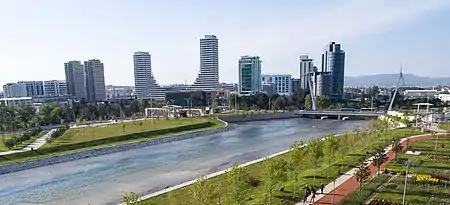 Skyline of Bursa
Skyline of Bursa Esenboğa International Airport (2006) in Ankara.
Esenboğa International Airport (2006) in Ankara. Sancaklar Mosque, Istanbul (2013)
Sancaklar Mosque, Istanbul (2013) Minicity Theme Park, Antalya (2004)
Minicity Theme Park, Antalya (2004) Raif Dinçkök Yalova Cultural Center, Yalova (2011)
Raif Dinçkök Yalova Cultural Center, Yalova (2011) Maslak No.1 Office Building, Istanbul (2014)
Maslak No.1 Office Building, Istanbul (2014) Zorlu Center, Istanbul (2013)
Zorlu Center, Istanbul (2013)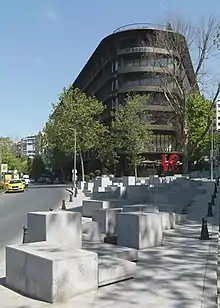 St.Regis Istanbul, Istanbul (2015)
St.Regis Istanbul, Istanbul (2015) Yalikavak Palmarina, Bodrum (2014)
Yalikavak Palmarina, Bodrum (2014) İzmir Adnan Menderes Airport
İzmir Adnan Menderes Airport Sakirin Mosque, The mosque's architect is believed to be the first woman to design a mosque. (2009)
Sakirin Mosque, The mosque's architect is believed to be the first woman to design a mosque. (2009) Ahmed Hamdi Akseki Mosque
Ahmed Hamdi Akseki Mosque Ahmed Hamdi Akseki Mosque
Ahmed Hamdi Akseki Mosque Izmir Folkart Towers
Izmir Folkart Towers.jpg.webp)

 Le Méridien in Etiler, Istanbul
Le Méridien in Etiler, Istanbul
.jpg.webp) Yavuz Sultan Selim Bridge (2016)
Yavuz Sultan Selim Bridge (2016) Yavuz Sultan Selim Bridge (2016)
Yavuz Sultan Selim Bridge (2016)
See also
Notes
- "Deutschsprachige Architekten in der frühen Republik" (in German). Goethe Institut. Retrieved January 20, 2012.
- "Michael Meeker. Review of Bozdogan, Sibel, Modernism and Nation Building: Turkish Architectural Culture in the Early Republic". H-Net Reviews, Humanities & Social Sciences Online. Retrieved February 2, 2012.
- "The 1950s and Modernism". ArchMuseum.org. Archived from the original on September 13, 2011. Retrieved January 21, 2012.
- "Mapping Turkey, Short History of Architecture". www.culturalexchange-tr. Archived from the original on December 11, 2011. Retrieved January 22, 2012.
- "The Search for Identity: 1st National Architecture Movement". ArchMuseum.org. Archived from the original on September 13, 2011. Retrieved January 20, 2012.
- "Architecture of the '30s in Turkey". Dogan Hasol, Arhitext Magazine, June 2007. Archived from the original on January 25, 2014. Retrieved January 20, 2012.
- "Tayyare Apartment Building". AtelyeMim.com. Retrieved February 2, 2012.
- "XIX. Yüzyış ve XX. Yüzyıl Başı Eminönü'nde Osmanlı Büro Hanları" (PDF) (in Turkish). Yıldız Teknik Üniversitesi-Fen Bilimleri Enstitüsü. Archived from the original (PDF) on 2012-06-16. Retrieved 2013-02-27.
- "Ankara - State Museum of Painting and Sculpture". Republic of Turkey, Ministry of Culture. Retrieved February 2, 2012.
- "Ankara - Ethnographical Museum". Republic of Turkey, Ministry of Culture. Retrieved February 2, 2012.
- "Bebek Mosque". ArchNet.org. Archived from the original on January 3, 2014. Retrieved February 2, 2012.
- "Kemer Hatun Mosque, Beyoglu, Istanbul" (in Turkish). MimarlikMuzesi.org. Archived from the original on July 21, 2012. Retrieved February 2, 2012.
- "Mass Housing Development by a Government Agency and the Politics of Urbanization" (PDF). 14th International Planning History Conference submission by Nilufer Baturayoglu Yoney and Yildiz Salman, Istanbul Technical University Faculty of Architecture, Turkey. Retrieved February 2, 2012.
- Cengizkan, Ali (2010). "The production of a mise en scène for a nation and its subjects: Clemens Holzmeister et al. in the Ministries Quarter for Ankara, Turkey". The Journal of Architecture. 15 (6): 731–770. doi:10.1080/13602365.2011.533539.
- "Florya Atatürk Marine Mansion". National Palaces of Turkey official web site. Archived from the original on November 10, 2011. Retrieved February 2, 2012.
- "Turkish Architectural Periodicals during the Republican Period, 1923-1980 by Ilker Ozdel at Dokuz Eylul University (Page 526)" (PDF). Çankaya University Journal of Humanities and Social Sciences, 7/2 (November 2010). Retrieved February 5, 2012.
- "The Ethos of Architects Towards an Analysis of Architectural Practice in Turkey, Thesis by Nilgun Fehim Kennedy, September 2005 (Page 23)" (PDF). Middle East Technical University, Turkey. Retrieved February 5, 2012.
- https://www.dunyabizim.com/images/haberler/haber/2016/04/25/ekrem-hakki-ayverdi.jpg
- "A New Perspective on National Architecture: 2nd. National Architecture Movement". ArchMuseum.org. Archived from the original on September 13, 2011. Retrieved January 21, 2012.
- "Architectural Profession Around the World, Turkey". The International Union of Architects. Retrieved January 21, 2012.
- "1960's (Turkish Architecture in the Republican Period)". ArchMuseum.org. Archived from the original on September 13, 2011. Retrieved January 22, 2012.
- "Modern Turkish Architecture (Renata Holod)". Academia.edu (University of Pennsylvania. Retrieved February 2, 2012.
- "1970's up to the Present (Turkish Architecture in the Republican Period)". ArchMuseum.org. Archived from the original on September 13, 2011. Retrieved January 22, 2012.
- "Istanbul's Unprecedented Property Boom Causes Concern About Citizens' Rights". Voice of America. Retrieved February 2, 2012.
- "New Tower to Dwarf Istanbul's Minarets". Wall Street Journal. Retrieved February 2, 2012.
- "Women Architects". Ustun Alsac. Retrieved December 10, 2013.
- "Istanbul Sapphire". E-Architect.co.uk. Retrieved February 2, 2012.
References
- Holod, Renata (2005). Modern Turkish architecture. Ankara: Chamber of Architects of Turkey.
- Bozdoğan, Sibel (2002). Modernism and Nation Building: Turkish Architectural Culture in the Early Republic. University of Washington Press.
Further reading
- Sibel Bozdoğan and Esra Akcan, "Turkey: modern architectures in history", Reaktion Books, 2012.
External links
| Wikimedia Commons has media related to Architecture of Turkey. |
